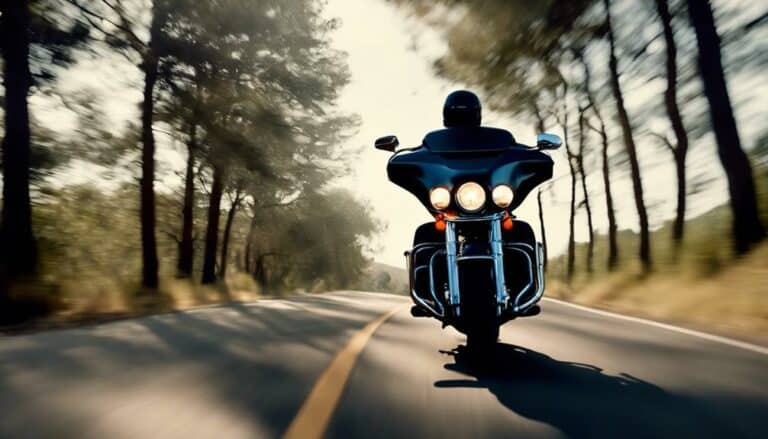When you cruise the road on your Harley Davidson Road Glide, it's like orchestrating through a symphony of wind instruments, each note shaping your ride.
But how does the wind truly impact your Road Glide's performance? The answer lies in a delicate dance between nature's forces and your motorcycle's design.
Stay tuned to uncover the secrets behind how the wind can make or break your two-wheeled journey.
Key Takeaways
- Frame-mounted fairing enhances stability and control in windy conditions.
- Proper wind management is crucial for a safe and comfortable ride.
- Windshield height deflects wind away, impacting rider comfort and fatigue.
- Meticulously crafted aerodynamic structure minimizes wind resistance for improved handling.
Wind's Impact on Stability
The frame-mounted fairing on the Harley Davidson Road Glide greatly enhances stability by effectively managing wind gusts. This design choice plays an important role in reducing wind buffeting, which can often destabilize a motorcycle when facing strong headwinds. By securely attaching the fairing to the frame, the Road Glide minimizes wind resistance, thereby improving overall stability even in challenging wind conditions. This means that riders can confidently navigate through headwinds and crosswinds without compromising control or safety.
The Road Glide's advanced wind management features not only enhance stability but also contribute to improved handling capabilities. When faced with windy conditions, riders can rely on the Road Glide to provide a stable and predictable riding experience. Additionally, the fairing's design aids in maintaining control and maneuverability, especially at slower speeds where wind gusts can have a more pronounced effect.
Influence on Handling and Control
Enhancing maneuverability and control, wind management features on the Harley Davidson Road Glide optimize rider experience in varying wind conditions. When handling the wind on your Road Glide, consider these key points:
- Adjust Your Riding: In windy conditions, stay relaxed and maintain a firm grip on the handlebars. Make subtle adjustments to your body position to counteract the wind force and keep the bike steady.
- Center of Gravity: Keep your center of gravity low by bending your elbows slightly and gripping the tank with your knees. This stable position helps you better handle gusts and crosswinds without losing control.
- Apply Pressure: When riding in high winds, lean slightly into the wind and apply gentle pressure on the handlebars in the direction of the gust. This technique helps you maintain stability and control, especially when faced with strong wind forces.
Effects on Aerodynamics and Speed
In considering the impact of wind on the Harley Davidson Road Glide's aerodynamics and speed, riders must acknowledge the pivotal role played by the bike's design in reducing wind resistance and enhancing stability at high speeds.
The aerodynamic structure of the Road Glide is meticulously crafted to minimize wind resistance, allowing for improved speed and fuel efficiency. However, when faced with headwinds or crosswinds, riders may experience challenges in maintaining stability and controlling the bike.
In such situations, adjustments in riding position and steering are vital to counteract the effects of the wind and guarantee a smooth ride. The fairing-mounted windshield further contributes to reducing wind drag and turbulence, enhancing the overall aerodynamics of the Road Glide.
Understanding how wind impacts aerodynamics is key to anticipating handling challenges and optimizing the riding experience on this powerful machine. By grasping the interplay between wind resistance, stability, and aerodynamics, riders can navigate varying wind conditions with confidence and finesse.
Importance of Wind Protection
For best wind protection on the Harley Davidson Road Glide, consider the windshield height and design impact. The Road Glide offers various fairing styles, and choosing the right one can greatly enhance your riding experience on windy days.
Here are three key factors to keep in mind when thinking about wind protection on your Road Glide:
- Windshield Height: The height of the windshield plays an important role in deflecting wind away from the rider. Opting for a taller windshield can provide better protection against wind buffeting, especially at higher speeds.
- Fairing Styles: Different fairing styles offer varying levels of wind protection. The frame-mounted windshield on the Road Glide is known for providing superior wind protection compared to fork-mounted fairings.
- Accessories: Accessories like fairing wind deflectors can further improve wind protection on your Road Glide. These additions help in directing airflow away from the rider, enhancing comfort and reducing fatigue on long rides.
Managing Wind Challenges
Considering the wind management features of the Harley Davidson Road Glide, understanding how to effectively navigate wind challenges is key to optimizing your riding experience. When facing wind gusts or crosswinds, proper wind deflection plays a critical role in maintaining stability and rider comfort. Adjusting the windshield height and utilizing wind deflectors can greatly impact how the Road Glide handles various wind conditions. To illustrate the importance of wind management accessories, let's examine the table below:
| Wind Management Aspect | Impact on Riding Experience |
|---|---|
| Fairing Design | Provides stability and wind deflection |
| Windshield Height | Affects the level of wind protection |
| Wind Deflectors | Enhances wind management in varying conditions |
| Crosswind Performance | Influences handling and rider comfort |
Conclusion
To sum up, when riding a Harley Davidson Road Glide, remember the saying 'Ride like the wind' to stay safe and in control.
Understanding how the wind affects your bike's stability, handling, and speed is essential for a smooth ride.
By managing wind challenges effectively and utilizing proper wind protection, you can confidently navigate through windy conditions.
Ride smart, ride safe, and let the wind be your guide.

